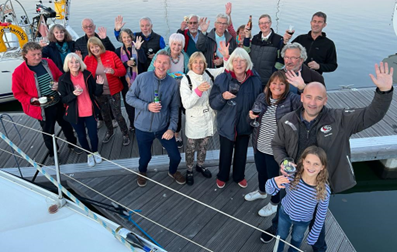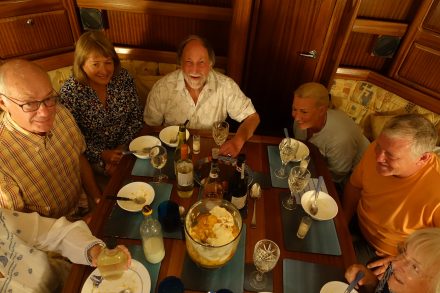- This topic is empty.
-
AuthorPosts
-
February 6, 2012 at 10:07 pm #6681
Anonymous
I have purchased and EchoTec 260-DML-1 watermaker. The Installation Manual cautions, “… keep away from the heat of the engine…” Of course, the engine compartment offers a handy location – save the temperature consideration. I have contacted EchoTec for their advice, but I’d appreciate actual Bavaria Owner experience with siting water makers in general and EchoTec units in particular.
Thanks for any feedback.
February 17, 2012 at 11:37 am #9053Anonymous
I have a Pur Survivor 80E on my Bav 40AC. It doesn’t have the output of yours though, only about 15litres an hour but uses much less power. I chose the enclosed, single unit, so I could fit it somewhere where the parts won’t get knocked. Eventually, we decided to fit it under the forward berth. This has the advantage of being a bit quieter, away from where most people would be. But we decided to avoid a new hole in the hull and fitted instead a branch off the engine inlet for raw water cooling and ran a hose from there. This does of course mean that we can only produce water while the engine is running but since we use it on long runs, batteries need to be charged, warm water produced etc, it’s never proven a problem. The test/priming water exits from the unit to the kitchen sink (or a bucket, when rinsing) and once tested, a switch passes it to the front water tank. We’ve never got round to a pump to fill both tanks – never really felt the need. I suppose if I was really clever (I’m not!) I could add a new divertor to the water pressure pump to pump from the forward tank to the rear one.
In terms of whether or not to site near the engine, if you have one of those weather station things, then reset it and put the sensor in the engine compartment, broadly where you plan to put the watermaker. After an hour under motor, check the weather station to see the ‘max temperature recorded’. Then decide whether it’s safe! Water production is greater when water is warmer, so any gentle warming going in to the unit is probably useful. But there’s a difference between a bit warm and decidely hot when o rings are involved and all the other stuff that might not like it for long.
February 17, 2012 at 6:46 pm #9054Anonymous
Thanks for your reply. I recently determined the operating temps within the engine compartment and on a 20C day it ran at nearly 48C – too warm for the recommended max ambient temp for the DC motor. After considering cooling solutions for the unit and eng comp, I decided to give it a miss and consider forward locations. The unit arrived yesterday and as soon as I have time to check the components with the two forward compartments I’m thinking of now – the area under the forward L seating in the salon or under the V berth – I’ll put it in one of those two places.
I have in mind locating the control panel on the bulkhead to the left of the sinks with the diverter draining through the soon-to-be-not-so-used seawater gooseneck fitting on the left sink. I want to have adequate access to the filters and find a solution for the expected splashes and such when cleaning filters and the like. I liked your idea of tapping into the eng intake water and I may use a similar strategy of using the genet inlet water adjacent to the eng inlet water valve as the EchoTec has a booster pump included in the kit – I just have to determine if that will allow sufficient water flow to the high pressure pump. We’ll see how it plays out and I’ll post my solution after the installation.
February 21, 2012 at 2:26 pm #9059Anonymous
I guess either under the aft facing saloon seat or the V-berth would do fine. Not sure if the Ocean has the same space as the AC under the saloon seat but I think for mine (40AC), it’d be a bit tight (and, in any case, that’s where I store drinking water bottles and wine!). I checked the required input (raw) water flow rate before deciding on the engine inlet. Mine needs 128ltrs/hr. This is about 10 times it’s production, so you’d need double that. I suspect pinching some of the seawater flow before it reaches the engine will still leave more than enough. For the excess water from the watermaker, we ran a flexi pipe to the sink waste pipe, through the low level locker in the forecabin. From the saloon berth, this would be easier as it could go under the floor. However, we’ve sited our unit against the bulkhead under the V-berth and this is higher than the sink waste, ensuring drain. From the saloon berth, you may find you’ll end up with syphoning problems or some water remaining in the exit pipework. Hope this helps.
February 21, 2012 at 7:13 pm #9061Anonymous
Thanks for your feedback. The kit has two large filters plus another large filter for the fresh water flush and EchoTec have added an additional housing of the same 15″ filter canister size for a water hardening capability free of charge… go figure. When I inspected the contents of the shipping crate, thoughts of under-seat filter siting became untenable. I’m now finding that the max allowable distance for the high pressure hose is 7 metres, which includes hose from the high pressure pump to membrane to control panel. This is going to be close given the less-than-straight path from membrane to control panel in galley. I looked under the shower seat, which would have been good for the high pressure pump save for the large manual bilge pump and shower water drain pump. I’m not keen on locating the control panel remote from the galley sinks for a number of reasons. I’ve lived without a water maker in the past and the idea of serving that system instead of it serving me or it making more chores and messes defeats my objectives. So… I think I’ll potter about for awhile doing more thinking and measuring than installing before I sink the first mounting bolt.There’s a solution for everything…
March 19, 2012 at 9:39 pm #9004Anonymous
After gaining understanding regarding the installation restrictions for the modular components, I determined the most effective location for the water maker kit is siting the high pressure DC pump underneath the shower seat and the filter series and pressure vessel behind the shower wall mounted against the hull. I had a thru hull stainless fitting placed at the forward inboard corner of the shower undersea area, which should remain under water at all but extreme angles of heel and places it well over a metre forward of the head sink and head discharge ports. I’m using marine adhesive and short wood blocks to mount the filters induividually and I’m still sorting out how to mount the high pressure pump. Although it is a close fit for the bump and large manual bilge pump under the seat, there is sufficient space but making the rather heavy pump secure remains under consideration. There is room to operate the thru hull ball valve without difficulty.
Removing the hull-side shower wall wasn’t an option – it was sika’d solidly on all four sides without space to prise off… I cut through the wall leaving a 70mm border in the wall I’ll use to secure a hinged access door. That way, accessing the filter array will be convenient and I’m installing a drip tray beneath the filters to catch water when servicing them. I’m installing a swivelling / telescoping gooseneck faucet in the head sink counter against the shower wall. I’m mounting the control panel in the new hinged access door in the shower. Only two thick wire bundles and the bilge pump hose occupied the lower with of the area behind the wall making the location of the filters a good use of previously unused space.
The components of the system are all located within a metre – including the waste output. It’s a owner-doable project, but it is more time consuming than one might initially estimate. I’ll upload photos when the installation is completed and the unit is making potable water.
July 30, 2012 at 10:37 pm #9187Anonymous
Installation completed and system operational producing 50 litres per hour. I was able to complete the installation myself; however, it was not a speedy process. Getting everything to fit in the space, mounted, and plumbed correctly took some time. The Owner’s Manual would benefit from a technical writer’s rewrite to make it clear to those unfamiliar with watermakers in general. I received excellent product support from the manufacturer as well as the Australian Distributor. I am quite pleased with the water maker as well as the installation and function.
-
AuthorPosts
- You must be logged in to reply to this topic.




